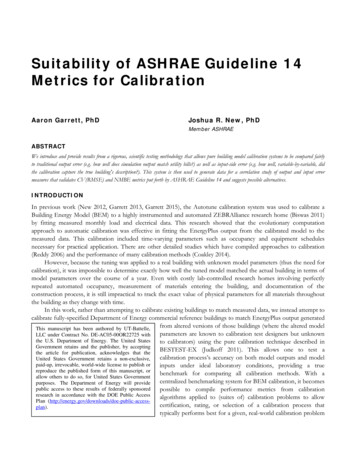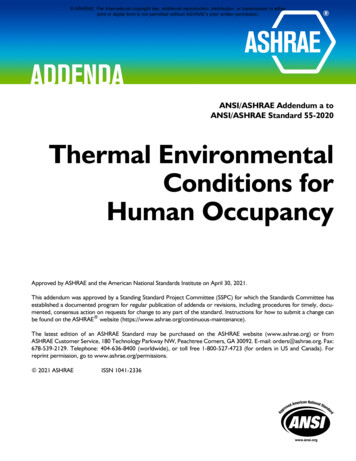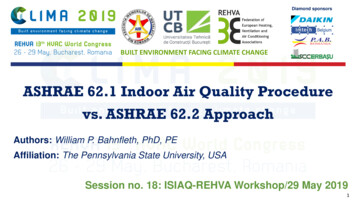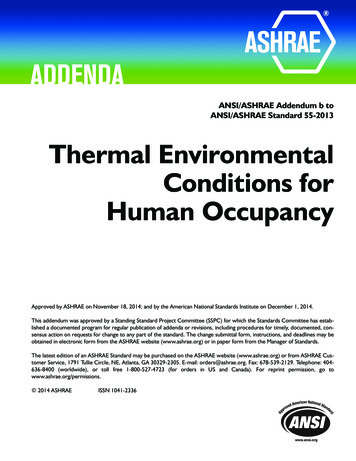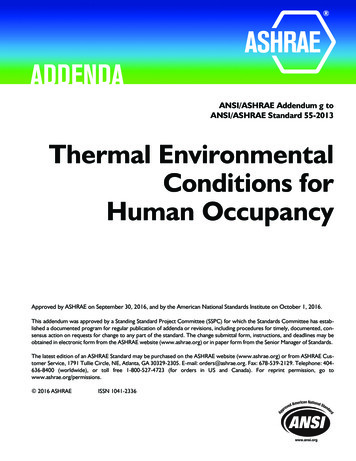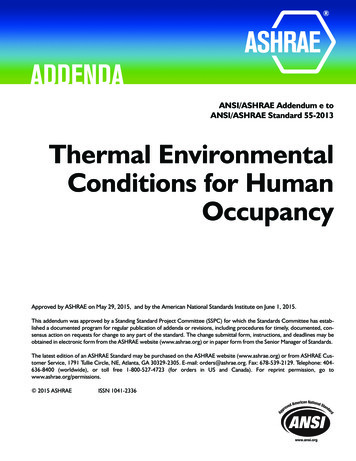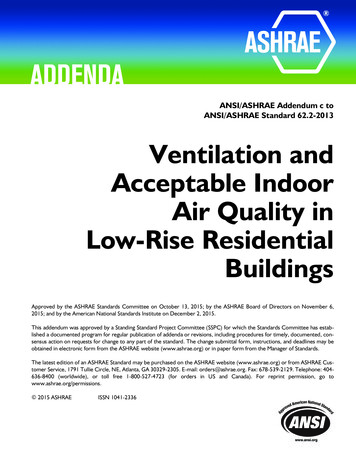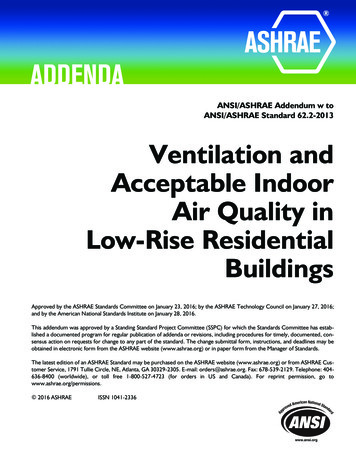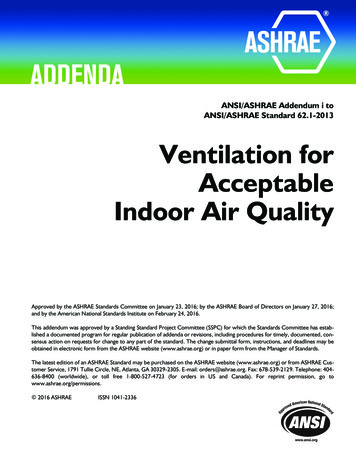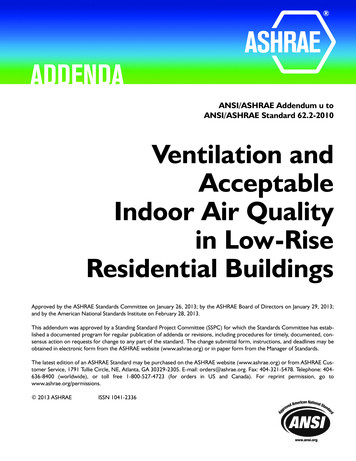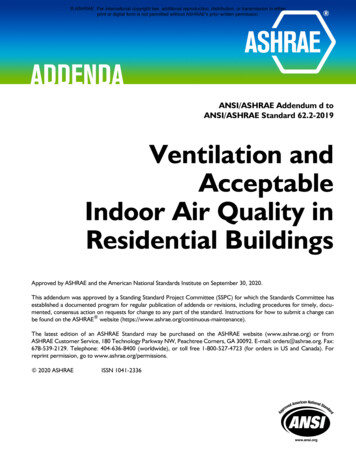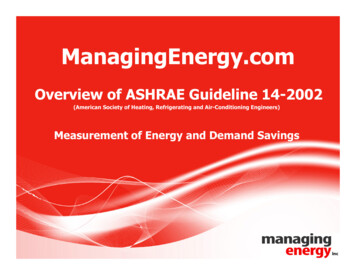
Transcription
ManagingEnergy.comOverview of ASHRAE Guideline 14-2002(American Society of Heating, Refrigerating and Air-Conditioning Engineers)Measurement of Energy and Demand Savings
ASHRAE Guideline 14-2002 OverviewMeasuring Energy SavingsTo assess the savings resulting from an Energy Conservation Measure Must be able to compare before and after energy use while alsoaccounting for non-ECM factors. ManagingEnergy.com provides a user-friendlyinterface to comply with the guideline, which isthe de-facto international standard.“The purpose of ASHRAE Guideline 14-2002is to provide guidelines for reliablymeasuring the energy and demand savingsdue to building energy managementprojects.”
ASHRAE Guideline 14-2002 OverviewMeasuring Energy SavingsThere are no direct ways to measure energy savings Instruments can only measure the presence of energy use and demandEnergy savings can only be determined indirectly The absence of energy use and demand can be calculated bycomparing the energy use and/or demand from before and after theimplementation of an energy conservation measure (ECM) Statistical methods are used – can be complexThis simple comparison does not differentiate betweenthe energy impact of the ECM and other factors such asweather and occupancy
ASHRAE Guideline 14-2002 OverviewMeasuring the impact of an Energy Conservation MeasureRequirements Must be able to project the energy use or demand patterns from the preretrofit (baseline) period into the post-retrofit period. Projection must take into account all major energy-governing variables.
ASHRAE Guideline 14-2002 OverviewMeasuring the impact of an Energy Conservation Measure
ASHRAE Guideline 14-2002 OverviewApproaches for Measuring Savings – Circumstances suggest best optionWhole Building Approach Uses a “main” meter to measure energy flowECMs may be applied to one or more of the systems served by the meterMight involve the use of monthly utility bill dataOption of two paths (prescriptive or performance)Retrofit Isolation Approach Uses meters to isolate the energy use and/or demand of the subsystems affected bythe ECM pre and post-retrofitWhole Building Calibrated Simulation Approach Uses computer simulation software to model facility energy use and demand Model is calibrated against actual energy use and demand data Calibrated model is used to predict energy use and demand of the post-retrofit period
ASHRAE Guideline 14-2002 OverviewSelecting an ApproachMost typicalme method
ASHRAE Guideline 14-2002 OverviewApproaches: Common ConsiderationsSelection of Relevant Independent Variables Variables which represent forcing functions of the energy-using system “t-test” should be used to determine which variables are significant The most significant variables should be measured over the period ofinterest Unaccounted for variables are the primary source of uncertainty in anycomputed savingsExamples of Relevant Independent Variables Weather (temperature, humidity, cloud cover and wind) Occupancy (floor area rented, sales, hotel vacancy rates) Production (items produced, shifts)
ASHRAE Guideline 14-2002 OverviewApproaches: Common ConsiderationsDocumenting Baseline Conditions Changes in the design or use of the building may lead to aninvalid/outdated baseline model Recording baseline conditions can aid in model revisions Common conditions include Occupancy patterns, densities, schedules, and type for each typical season.Average throughput or plant loads in each operating modeOperating schedules and key set points of energy-using systems for alloperating modesNon-routine functions of the facility, their dates, and impacts on operationThe nature and timing of any breakdown of significant energy-usingequipmentEquipment nameplate dataMe energy auditing anddocument managementfeatures provide keyprocess support.
ASHRAE Guideline 14-2002 OverviewWhole Building ApproachThe Whole Building Approach encompassesprocedures that verify the performance of retrofitswhere whole building pre- and post-retrofit data areavailable.Appropriate for complex, multi-phaseprojects as opposed to one or twocontained retrofits.
ASHRAE Guideline 14-2002 OverviewWhole Building Approach: PathsThere are two possible paths which can be takenWhole Building Prescriptive Path Expected Savings 10% Energy data is continuous (no exclusions) in pre- and postretrofit dataWhole Building Performance Path Energy data is not continuous More forgiving of data availability Statistical methods assess validityNormal memethod.Managing Energy uses the Whole Building Performance Path
ASHRAE Guideline 14-2002 OverviewThe Baseline ModelThe regression process yields a statistical model in the following form
ASHRAE Guideline 14-2002 OverviewBaseline AdjustmentsNeeded when changes to the facility occur during the post-retrofit period.Option 1 (preferred) Sub-meter the effect if possible Post-retrofit data is then simply the total metered amount less the submetered quantityOption 2 Account for the adjustment in the modelManaging Energy supportsoption, with either an actualsubmeter or virtual(calculated) submeter.
ASHRAE Guideline 14-2002 OverviewIdentifying an Optimal Baseline ModelThe guideline recommends the optimal model be selected based on ameasure of the goodness of fit.R²: Coefficient of Determination Indicates the proportion of response variation“explained” by the regressorsCV(RMSE): Coefficient of Variationof the Root Mean Squared Error Indicates the uncertainty in the model
ASHRAE Guideline 14-2002 OverviewIdentifying an Optimal Baseline ModelR²: Coefficient of DeterminationR² 1 All variability in the response variable can be explained by the regressors. Approximately 80% of the variation in the in the response variable can explained bythe regressors.R² 0.8R² 0 None of the variation in the response variable can be explained by the regressors. No relationshipIdeally you want R² 0.8BUT NOTE:“Correlation does not implycausation”R
ASHRAE Guideline 14-2002 OverviewIdentifying an Optimal Baseline ModelCV(RMSE): Coefficient of Variation of the Root Mean Squared Error A measure of uncertainty in the model Whole Building Prescriptive PathPost-Retrofit Period CV(RMSE) 20% for energy use 12 months CV(RMSE) 30% for demandPost-Retrofit Period CV(RMSE) 25% for energy use12 60 months CV(RMSE) 35% for demandPost-Retrofit Period CV(RMSE) 30% for energy use 60 months CV(RMSE) 40% for demandManaging Energy supportsthe Whole BuildingPerformance Path butCV(RMSE) can be usedinterchangeably with R²
ASHRAE Guideline 14-2002 OverviewIdentifying an Optimal Baseline ModelA well correlated model is not always a good model Compliance indicators can be helpful in assessing whether a model issoundmanagingenergy provides a quick compliance check in the modeling view
ASHRAE Guideline 14-2002 OverviewCompliance: CV(STD)Coefficient of Variation of the Standard Deviation Another measure of model uncertainty Used to compute savings uncertainty when the baseline energy use ordemand is essentially the same in all periods
ASHRAE Guideline 14-2002 OverviewCompliance: NMBENormalized Mean Bias Error Yet another measure of model uncertainty A compliance criteria for the Whole Building Simulation Approach
ASHRAE Guideline 14-2002 OverviewCompliance: Net Determination BiasDefinition The net determination bias test shall apply the baseline independentvariable data to the algorithm for savings determination to re-computean algorithm-determined baseline energy usage or demand for each ofthe n baseline data points (i). These re-computed quantities are thencompared to the actual baseline energy usage or demand (i) in thebaseline period to derive the net determination bias.To comply with the guideline: net determination bias 0.005%
ASHRAE Guideline 14-2002 OverviewCompliance: Net Determination Bias
ASHRAE Guideline 14-2002 OverviewCompliance: Includes All Operating ModesBaseline periods, which span all modes of system operation are needed toreduce uncertainty in computed savings A facility which operates on a annual cycle in response to weathershould have a baseline period of a least one full year Period immediately prior to retrofit is preferred Operations are most likely representative of post-retrofit periodEasily remembered by facility staff and thus least likely to introduce bias orerror due to unaccounted significant variablesManaging Energy determines if the baseline model containsdata from each month of the year.
ASHRAE Guideline 14-2002 OverviewCompliance: Balanced RepresentationCare should be taken to ensure all modes of system operation arerepresented equally. Failure to do so may result in over representing one operational modeand thus introducing bias into the model (e.g. summer months thanwinter months) Most easily achieved by using an integral number of continuous 12month periods (e.g. 12, 24, 36 months), not partial years (e.g. 7, 15, 30months)Managing Energy computes the “amount” of data within each of the 12months and ensures that all months are approximately balanced.
ASHRAE Guideline 14-2002 OverviewCompliance: Balanced Representation
ASHRAE Guideline 14-2002 OverviewCompliance: Balanced RepresentationWinter monthsare now overrepresented
ASHRAE Guideline 14-2002 OverviewCompliance: Data Elimination“No more then 25% of measured data shall be excluded” Reasons should be given for data gaps, data elimination or estimationsof any measured data in the baseline or post-retrofit periodThe period in which Managing Energy computes eliminated data beginswith the most historic data point and ends with the most recent
ASHRAE Guideline 14-2002 OverviewGetting there in mec2131 Pick the meter2 “Performance Baselines” tab3 Model button4 Interactivemodeling screen
ASHRAE Guideline 14-2002 Overview There are two possible paths which can be taken Whole Building Prescriptive Path Expected Savings 10% Energy data is continuous (no exclusions) in pre- and post-retrofit data Managing Energy uses the Whole Building Performance Path Whole Building Performance Path Energy data is not continuousFile Size: 1MBPage Count: 27
